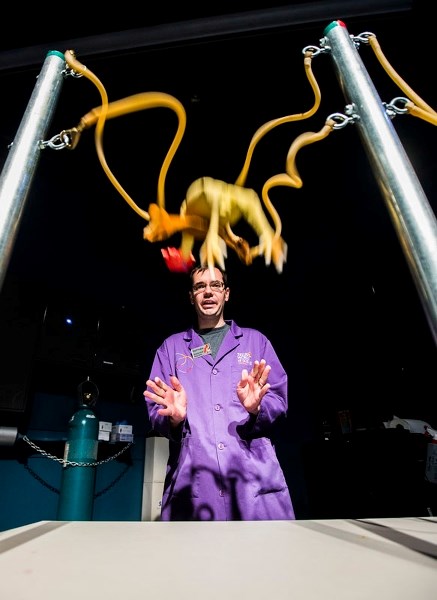Trigger-happy science-fans will get the chance to go full-auto this week as part of an adults-only event on projectiles in Edmonton.
About a thousand Edmonton-area residents are expected to come to the Telus World of Science Thursday for the Dark Matters event. These semi-regular events are meant to give those 18-and-up a chance to explore the science centre while it’s free of kids and socialize over science.
This month’s event is all about the science of projectiles, said staff scientist Marie McConnell. Staffers came up with the theme as a way to tie into the centre’s Angry Birds exhibit and give themselves an excuse to play with catapults.
“We’re going to be playing with Nerf guns, we’re going to be trying to throw axes, we’re going to be looking at ancient spears,” she said, as well as many other forms of projectile.
“We’ll be launching a whole lot of them!”
McConnell said guests would also get to learn about the science behind projectiles, which includes many basic principles of momentum, gravity, and potential and kinetic energy.
“They (projectiles) are a really awesome way to start exploring some simple principles of physics.”
MacEwan University lab instructor Katie Biittner will be on hand to discuss prehistoric projectiles such as the atlatl (pronounced “attle-attle”), or spear-thrower, which first appeared in North America about 10,000 years ago.
“If you’re hunting big animals, you really don’t want to get up close to them,” Biittner said.
Back in the Stone Age, humans and Neanderthals had to hunt large animals using stone tools such as spears, she explained. This was dangerous, and archaeologists have found evidence that our ancestors were often injured or thrown during these hunts. Throwing spears gave people a little more range, but those were limited by a person’s arm strength.
The atlatl was a stick about the length of your forearm with a grip on one end and a hook on the other, Biittner said. You lay your spear on top of the stick with the butt against the hook, holding it with your fingertips like a dart with the rest of your hand wrapped around the stick’s grip. You then cock your elbow and whip the stick forward. The stick acts as a miniature catapult, granting you increased leverage and throwing power.
Projectiles were important developments for prehistoric humans, as they let hunters wound prey at a safe distance and run them to exhaustion, Biittner said. The creation of the bow and arrow about 3,000 years ago gave humans even more range, and used lighter projectiles that required less stone to make.
Biittner said she would have replicas of ancient atlatls at the Telus and would help visitors make their own from chopsticks and skewers.
In addition to sampling drinks at the bar, guests will get to shoot at targets using Nerf guns supplied by the Foundry Athletic Training Centre, McConnell said. There will also be talks on neutrinos, exhibits of meteorites, ballistic chickens and eight-foot tall liquid fuelled rockets.
The event starts at 7 p.m. this March 9. Tickets are $19.95. Visit telusworldofscienceedmonton.com for details.




